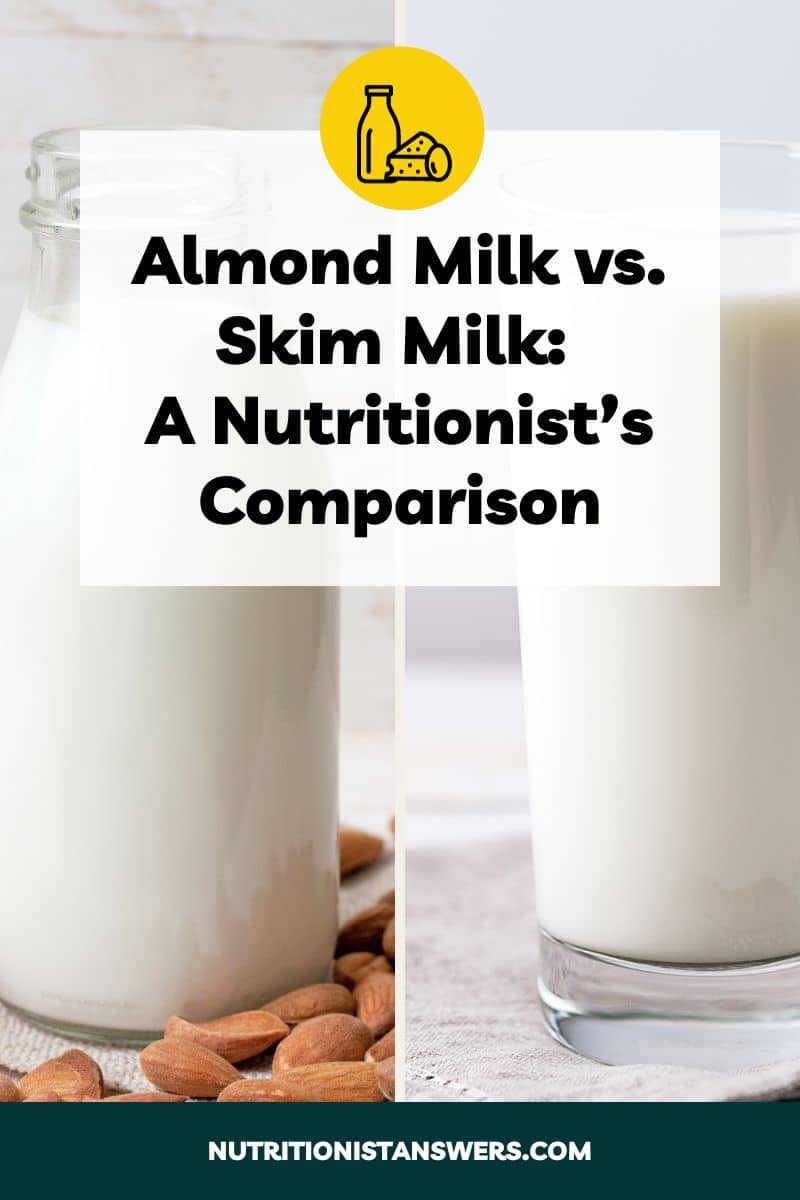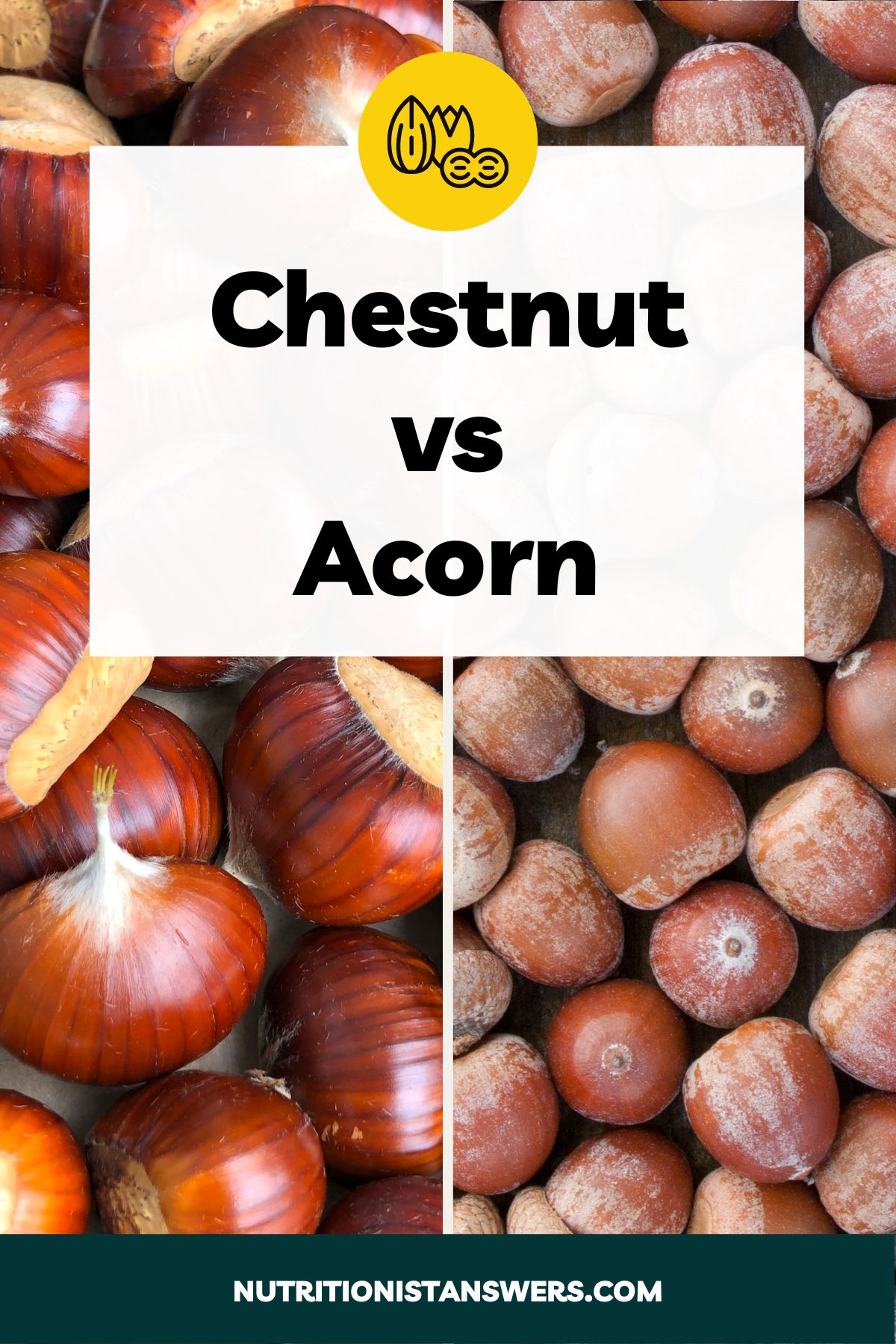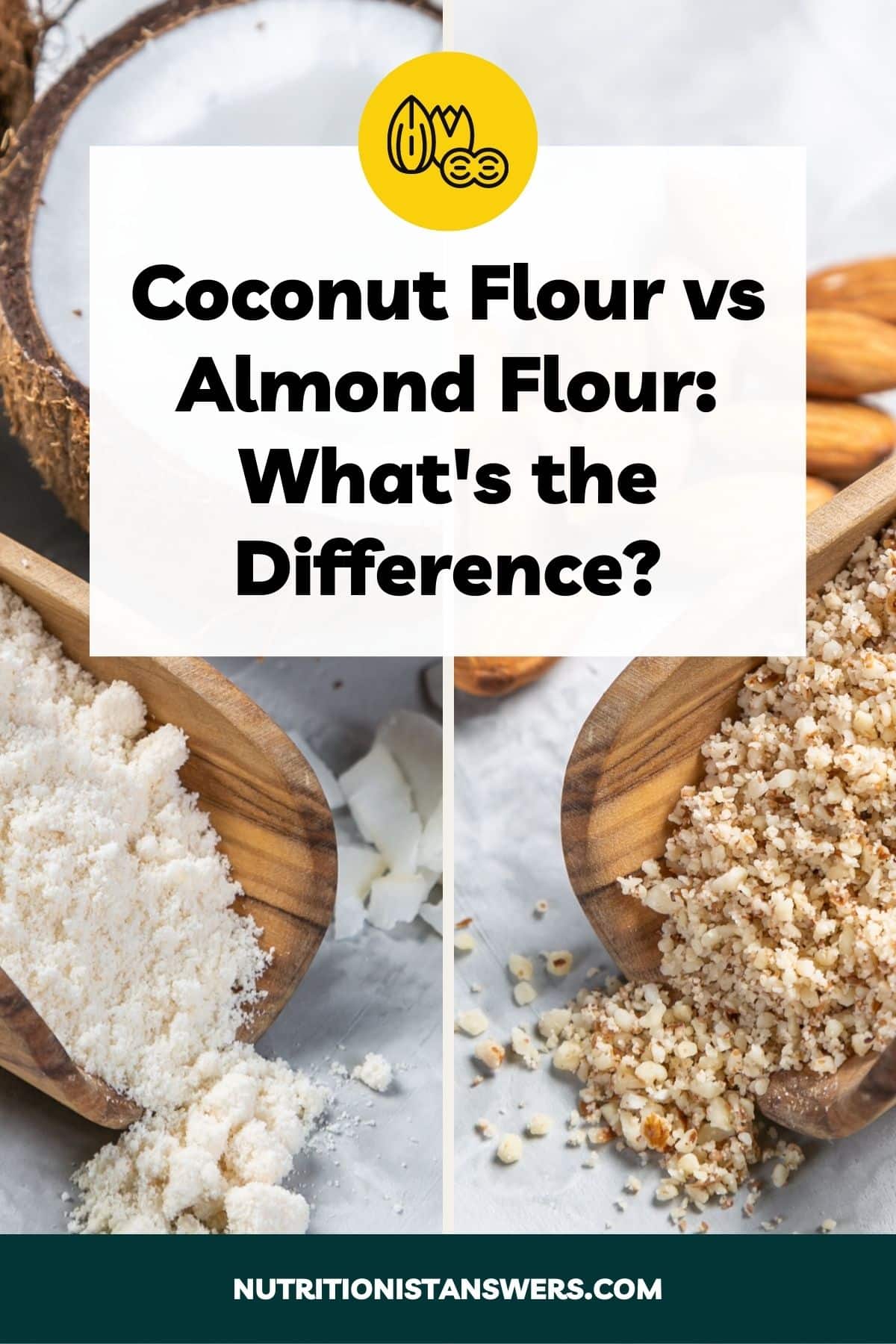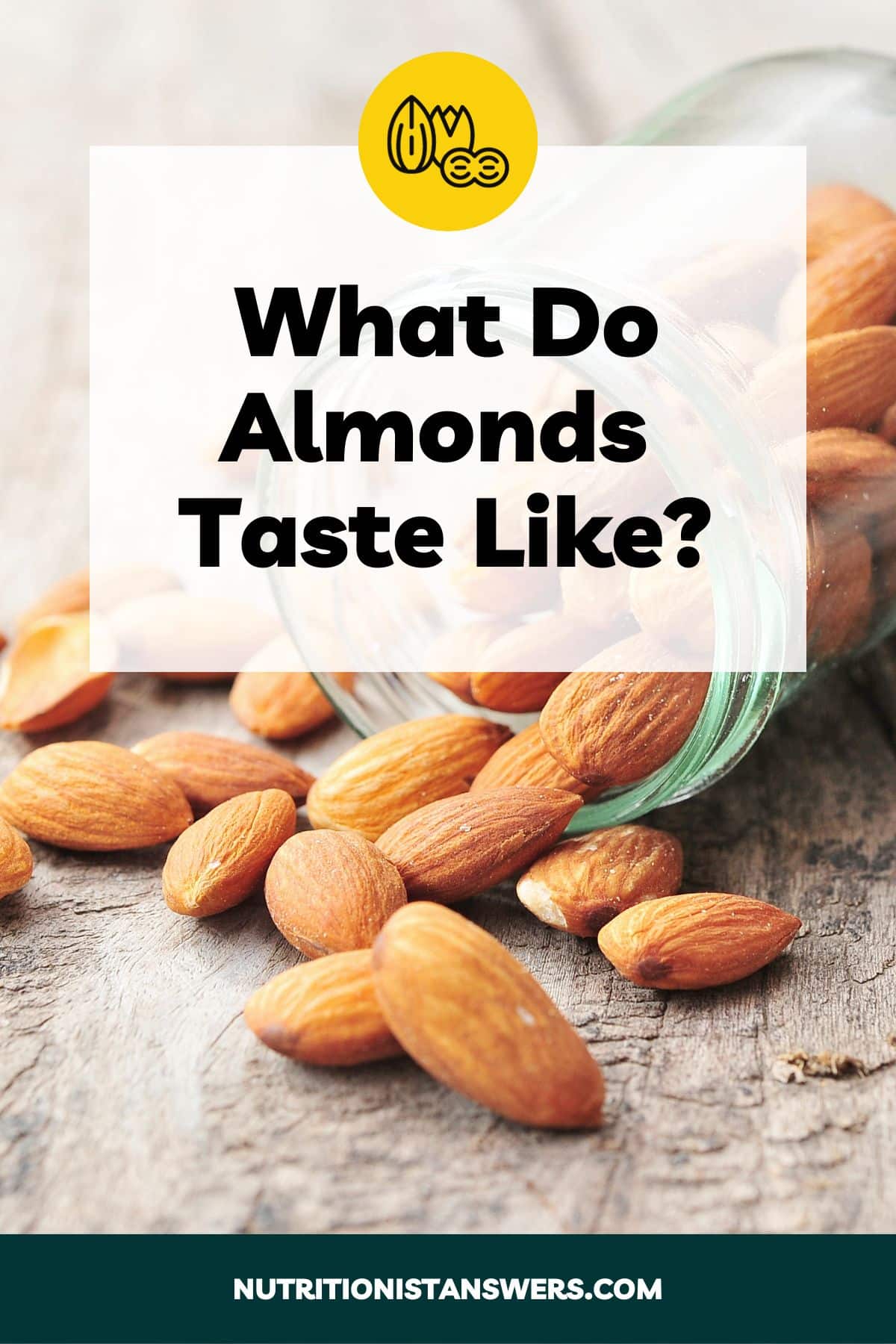Skim milk is a popular type of cow’s milk with a neutral taste, while almond milk is a non-dairy beverage known for its sweet, nutty flavor.
The nutrient content of almond milk varies widely based on how many nuts are used, but in general, almond milk is slightly higher in fat than skim milk, while skim milk is higher in protein and carbohydrates than almond milk.
Both skim milk and fortified almond milks are high in calcium and vitamins A and D. Almond milk tends to contain more vitamin E, because almonds are naturally high in this nutrient.
Here’s a more detailed review of how they compare in terms of flavor, nutrition, available forms, and uses.
Flavor comparison
Skim milk and almond milk are both mildly sweet, but almond milk offers a nuttier flavor, while skim milk has more of a neutral taste.
Both almond milk and skim milk have a creamy texture. However, high-quality versions of almond milk may be creamier than skim milk because they tend to use a high percentage of almonds.
Compared to whole cow’s milk, almond milk and skim milk are sweeter and less creamy.
Nutrition comparison
While skim milk nutrition is straightforward and consistent, almond milk nutrition can vary depending on how many almonds are used to make the milk and how they are processed.
For example, almond milk can contain as little as 2% or up to 20% almonds (1, 2, 3). All of the naturally-occurring nutrients in almond milk come from the almonds, so products made with fewer almonds will be lower in most nutrients.
Additionally, some almond milk products are fortified with calcium and vitamins A, D, and E. Skim milk, on the other hand, almost always includes added vitamins A and D.
Here’s a side-by-side comparison of the calorie and macronutrient content of almond milk and skim milk, based on an 8-ounce (1-cup) serving size:
| Nutrient | Almond milk (8 oz) (4, 5, 6, 7, 8, 9) | Skim milk (8 oz) (10) |
| Calories | 30-130 | 83 |
| Protein | 1-5 grams | 8 grams |
| Fat | 3-11 grams | <0.5 grams |
| Carbohydrates | 1-3 grams | 12 grams |
| Fiber | 0-3 grams | 0 grams |
| Sugars | 0-1 gram | 13 grams |
Calories
Skim milk tends to be higher in calories than store-bought almond milks and those made with a lower percentage of almonds, but lower in calories than high-quality almond milks.
Brands of almond milk like Almond Breeze, Silk, and Califia Farms offer only 30-35 calories per serving, while Malk and Elmhurst contain 70 and 130 calories, respectively.
Meanwhile, one cup of skim milk provides 83 calories, most of which come from protein and carbohydrates.
Note that sweetened and flavored versions of almond milk will likely be higher in calories due to added sweeteners and other ingredients.
Protein
Skim milk is much higher in protein than most brands of almond milk. Just one cup of skim milk provides 8 grams of protein, while almond milk can contain as little as 1 gram.
Almond milk brands like Almond Breeze, Silk, and Califia Farms contain 1 gram of protein per serving. Higher-quality options like Elmhurst can contain 5 grams of protein or more.
Skim milk may be a better choice if you’re aiming for a high-protein diet. Another option is to add protein powder to your almond milk.
Fat
With less than 0.5 grams per serving, skim milk is lower in fat than almond milk. Most of the naturally-occuring fat in skim milk is removed during processing.
Brands of almond milk made with a lower percentage of nuts, like Silk and Almond Breeze, have around 2-3 grams of fat per serving.
Meanwhile, homemade versions of almond milk and higher-quality brands, like Elmhurst, can contain up to 11 grams of fat per serving.
Carbohydrates
Unsweetened almond milk is up to 92% lower in carbohydrates than skim milk.
An 8-ounce glass of skim milk offers 12 grams of carbohydrates, while an equal serving of unsweetened almond milk contains only 1-3 grams.
Keep in mind that sweetened versions of almond milk may actually contain more carbohydrates than skim milk due to added sugars.
Vitamins and minerals
Many store-bought almond milk products are fortified with calcium and vitamins A, D, and E, and skim milk almost always includes added vitamins A and D.
However, unfortified products and homemade versions of almond milk are not a good source of calcium, vitamin A, or vitamin D.
Here’s a side-by-side comparison of the vitamin and mineral content of unsweetened almond milk and skim milk, based on a 1-cup (8 oz) serving size. We’ve included both fortified and unfortified versions of almond milk:
| Nutrient | Almond milk, unsweetened, unfortified (8 oz) (4, 8, 9) | Almond milk, unsweetened, fortified (8 oz) (5, 6, 7) | Skim milk, fortified with vitamins A & D (8 oz) (10) |
| Vitamin A | Not listed | 140-200 mcg (16-22% DV) | 149 mcg (17% DV) |
| Vitamin D | 0 mcg (0% DV) | 2-5 mcg (10-25% DV) | 3 mcg (15% DV) |
| Vitamin E | Not listed | 4-7.5 mg (27-50% DV) | <0.1 mg (<1% DV) |
| Sodium | 5-10 mg (<1% DV) | 140-170 mg (6-7% DV) | 103 mg (4% DV) |
| Potassium | 80-160 mg (2-3% DV) | 40-170 mg (1-4% DV) | 382 mg (8% DV) |
| Calcium | 40-70 mg (3-5% DV) | 440-470 mg (34-36% DV) | 299 mg (23% DV) |
| Magnesium | Not listed | 0-15 mg (0-4% DV) | 27 mg (6% DV) |
| Iron | 0-1 mg (0-6% DV) | 0.2-0.7 mg (1-4% DV) | 0.1 mg (1% DV) |
Special diets
If you’re following a special diet, you may be wondering whether almond milk or skim milk is a better choice for you.
Dairy free diet
Most almond milk is dairy-free. It’s possible for almond milk to contain additives derived from dairy, but this isn’t common.
Milk is produced by cows, so it is considered a dairy product. Skim milk should be avoided on a dairy-free diet.
Gluten free diet
Both skim milk and almond milk are naturally gluten-free.
However, it’s possible for almond milk to include gluten-containing additives. Most almond milk brands are gluten-free, but always check the label to be sure.
Ketogenic diet
For people following a keto diet, unsweetened almond milk is a better choice than skim milk.
Unsweetened almond milk has 1-3 grams of carbs and 0-3 grams of fiber per cup, while an equal serving of skim milk contains 12 grams of carbs and no fiber.
Skim milk can still be enjoyed on a keto diet, but a typical serving (8 ounces) can easily take up 25-60% of your total daily carb allowance (11).
Sweetened and flavored versions of almond milk should also be limited or avoided on a keto diet. They can contain anywhere from 8 to 21 grams of carbs per serving (12, 13, 14).
Low fat diet
Skim milk is very low in fat, with less than 0.5 grams per 1-cup (8-ounce) serving, making it an ideal milk choice for people who need to limit their fat intake.
Almond milk, on the other hand, can contain anywhere from 3 to 11 grams of fat per serving. The most popular brands, like Almond Breeze and Silk, are on the lower end of this range.
For reference, low-fat diets tend to limit fat to 30% or less of total daily calorie intake (15). On a 2,000-calorie diet, that’s about 67 grams of fat per day.
Low-FODMAP diet
Almond milk is considered low-FODMAP, but skim milk is not, according to the Monash University FODMAP Diet app.
Skim milk is high in the FODMAP lactose in typical serving sizes. To make skim milk low-FODMAP, you’d need to limit your serving to just one tablespoon.
Almond milk is considered low-FODMAP in servings of one cup (8 ounces), despite the fact that almonds are high in a type of FODMAP called galactans. This is likely because almond milk is mostly water and tends to contain very few almonds.
Low sodium diet
Skim milk is considered a low-sodium food, because it contains less than 5% of the Daily Value (DV) for sodium (16).
Almond milk is naturally low in sodium, but many brands add salt for flavor. Depending on the brand, almond milk can contain anywhere from 5 mg to 170 mg of sodium.
If you’re following a low-sodium diet, which limits sodium to less than 2300 mg, you may want to choose skim milk or a brand of almond milk with no added salt (17).
Vegetarian diet
Skim milk is not vegetarian, because it comes from cows.
Almond milk is vegetarian because it does not contain any animal products.
Vegan diet
Almond milk is vegan, unless it has been sweetened with honey. Skim milk is not vegan, because it is produced by cows and is therefore considered an animal byproduct.
Available forms
1. Refrigerated (almond milk and skim milk)
Both skim milk and almond milk are available in refrigerated cartons or jugs, which can be found in the refrigerated dairy section of the grocery store.
Almond milk can be sweetened or unsweetened and comes in a variety of flavors, such as chocolate and vanilla. Skim milk, on the other hand, is usually plain and unsweetened.
Refrigerated milks must stay refrigerated and are best if used within 7-10 days after opening. If possible, keep them in the back of the fridge, where temperatures are coldest.
2. Shelf-stable cartons (almond milk and skim milk)
Shelf-stable cartons of almond milk and skim milk are packaged in aseptic cartons, which allows them to be stored at room temperature for an extended period of time without refrigeration.
Because it can be stored at room temperature, shelf-stable skim milk is ideal for people who don’t have access to refrigeration, or those who would like to keep a backup supply of milk in the pantry.
You’ll find shelf-stable milks in the baking or beverage aisles of the grocery store. Almond milk is available sweetened or unsweetened and in various flavors, while skim milk is typically plain.
Unopened shelf-stable milk stays fresh for up to 6 months. Once the package is opened, milk should be refrigerated and used within 7-10 days.
3. Powdered (almond milk and skim milk)
Powdered versions of both skim milk and almond milk are available. These products are usually sold in resealable packets or jars and are meant to be mixed with water, coffee, or other liquids.
Skim milk powder (more commonly known as nonfat dry milk) is made by removing at least 95% of the water from pasteurized skim milk (18). You can find it in the baking aisle of most grocery stores.
Almond milk powder is less popular but can be purchased online and may be available at some health food markets. It is made from almonds that have been ground into a fine powder.
Powdered milks are shelf-stable and should last for at least 12 months when sealed and stored properly. Once mixed with liquid, they must be refrigerated and used within a few days.
4. Concentrated (almond milk only)
Almond milk concentrate is similar to almond butter, but it’s made with unroasted almonds and no other ingredients.
You can use almond milk concentrate to make your own almond milk at home by simply blending 1-2 tablespoons of concentrate with 8 ounces of water.
Almond milk concentrate comes in jars or squeezable packets and can be purchased online. JOI and Wilderness Poets SPiN are popular brands.
Almond milk concentrate is shelf stable and stays fresh for several months. However, almond milk made from concentrate should be refrigerated and used within 7-10 days.
5. Evaporated (skim milk only)
Evaporated skim milk (also called evaporated fat free milk) is made by heating skim milk until about 60% of the water has evaporated, resulting in a thicker and creamier liquid.
Compared to fresh milk, evaporated milk has a sweeter, slightly caramelized flavor. It is typically used to add richness and creaminess to soups, sauces, baked goods, custards, and ice creams.
In the grocery store, you can usually find evaporated milk (sold in cans) in the baking aisle or near the other shelf-stable milk products.
Evaporated milk can be stored at room temperature and should stay fresh for at least 6 months. Once opened, transfer any unused portion to a sealed container and refrigerate for up to 5 days.
6. Sweetened condensed (skim milk only)
Sweetened condensed milk is made by removing about 60% of the water from fresh cow’s milk and adding sugar to create a thick, syrup-like liquid.
It tastes very rich and sweet with a caramel-like flavor, making it a popular ingredient in desserts and sweet treats like tres leches cake, key lime pie, and rice pudding.
You’ll find cans of sweetened condensed milk in the baking aisle at the grocery store. Both fat free and full fat versions are available.
Sweetened condensed milk can be stored unopened at room temperature and should stay fresh for around 6 months. After opening, refrigerate and use within 5 days.
7. Creamer (almond milk only)
Creamers are concentrated versions of milk that have been blended with other ingredients such as oils, flavorings, and sweeteners, resulting in a thick and creamy liquid.
They are designed to be added to coffee and tea drinks, offering a rich and velvety texture while also enhancing the flavor of the beverages.
Almond milk creamer can be found in the refrigerated section of the grocery store. While dairy-based creamers are common, we aren’t aware of any that use skim milk as a base.
Creamers must be refrigerated and should be used within 7-10 days of opening.
Cost
Skim milk and almond milk are similarly priced, although it depends on the brand.
In general, a half gallon of skim milk or almond milk costs between $2 and $4. However, organic skim milk and higher-quality brands of almond milk may cost more than $4.
Recommended uses
Almond milk and skim milk can be used in many of the same ways.
1. As a beverage
Both almond milk and skim milk can be used as beverages in various ways, each offering a distinct flavor and nutritional profile.
Almond milk, a dairy-free alternative, is an excellent choice for those with lactose intolerance or anyone who avoids dairy products. Its slightly nutty taste pairs well with coffee and tea, but it can also be added to smoothies.
Skim milk, on the other hand, may be a better choice for people following low-fat diets or those who prefer a traditional milk flavor. It’s commonly used in coffee, tea, and protein shakes, where it lends a slightly creamy texture.
2. In baked goods & desserts
Skim milk and almond milk can both be used in baked goods and desserts, but they offer different qualities that may influence your choice.
Almond milk adds a subtle nutty sweetness and is ideal for recipes where this flavor enhances the overall taste, making it particularly well-suited for pancakes, waffles, and muffins.
Just keep in mind that almond milk’s flavor may not be suitable for every type of baked good. For example, it may be too sweet for certain breads like focaccia and garlic bread.
Skim milk has a neutral taste, making it a versatile choice for a wide range of desserts, including cakes, puddings, and ice cream.
Due to its low fat content, skim milk can result in slightly drier baked goods compared to whole milk, so you might need to compensate by including additional fats or other moist ingredients.
3. In savory dishes
Almond milk and skim milk can both be incorporated into savory dishes, including cream-based soups, quiches, casseroles, curries, mashed potatoes, and creamed vegetables.
Almond milk, with its nutty sweetness, can be an excellent addition to dishes where this flavor enhances the overall taste. It pairs well with creamy soups, curries, or dishes that benefit from a slightly sweet undertone.
On the other hand, skim milk’s neutral taste makes it a versatile choice, suitable for a wide range of savory recipes. It’s particularly effective for creating creamy sauces without introducing any distinct flavor.
Ultimately, the choice depends on your preference and whether you want to accentuate the nutty notes of almond milk or maintain a more neutral profile with skim milk in your savory creations.
Final thoughts
Skim milk has a creamy, neutral taste with a hint of sweetness, while almond milk is nuttier but similarly sweet.
Almond milk is generally slightly higher in fat and lower in calories, protein, and carbohydrates. Both skim milk and fortified almond milks are high in vitamin A, vitamin D, and calcium, but almond milk contains more vitamin E.
Both milks are available in many different forms, including refrigerated, shelf-stable, and powders, and tend to cost about the same amount.
You can use either almond milk or skim milk as stand-alone beverages, in baked goods, or in savory dishes.Curious how almond milk compares to other milks? Check out our in-depth comparisons of coconut milk vs almond milk and cashew milk vs almond milk.
Amy Richter is a Registered Dietitian Nutritionist based in Missouri. She is an experienced nutrition writer and medical advisor for Healthline and Medical News Today. Amy is passionate about all things food-related and enjoys translating complex science into easy-to-understand articles.





